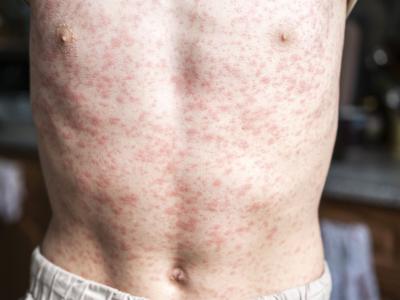Our weekly wrap-up of antimicrobial stewardship & antimicrobial resistance scans
BARDA boosts funding for development of new C difficile antibiotic
Summit Therapeutics yesterday announced that the Biomedical Advanced Research and Development Authority (BARDA) has awarded the company an additional $8.8 million for clinical and regulatory development of an investigational antibiotic for treating Clostridiodes difficile infection (CDI).
The additional funding is for a new clinical trial for ridinilazole in adolescent patients. Ridinilazole is a oral small-molecule antibiotic designed to selectively kill C difficile bacteria and preserve patients' beneficial gut bacteria, leading to sustained CDI cures. Summit, of Cambridge, Mass., says the adolescent trial is expected to support a New Drug Application for ridinilazole.
The award brings BARDA's total committed funding for the project to $62.4 million.
"BARDA's continued support for ridinilazole is instrumental in helping to bring this potential CDI treatment option to patients, whose current treatment options fail to sustain cures for one third of the population," Glyn Edwards, CEO of Summit, said in a company press release. "We thank BARDA for its commitment to ridinilazole, innovation and public health."
The Centers for Disease Control and Prevention estimates that there were 223,900 CDI cases in hospitalized patients in 2017, 12,800 CDI-related deaths, and $1 billion in attributable healthcare costs.
Jan 23 Summit Therapeutics press release
Initiative aims to mobilize investors in fight against drug resistance
At the World Economic Forum in Davos yesterday, a coalition of public and private-sector organizations announced an effort to engage the financial sector in tackling antimicrobial resistance (AMR).
The aim of the "Investor Year of Action on AMR" is to "leverage influence to make change happen," according to a press release from the Farm Animal Investment Risk & Return (FAIRR) initiative, which is one of the groups backing the effort. During the year-long initiative, investors will be encouraged to assess and integrate risks, opportunities, and impacts, and make investment decisions, with AMR in mind.
Other groups involved in the initiative include the UK Department of Health and Social Care, the Access to Medicines Foundation, and Principles for Responsible Investment (PRI).
"The World Bank believes AMR could cause greater economic damage than the 2008 financial crisis, potentially decreasing global annual GDP by up to 3.8% by 2050," said Fiona Reynolds, chief executive of PRI. "If investors fail to take action on antimicrobial resistance, the public health consequences could be catastrophic and entire sectors from food to pharmaceuticals face industry-wide risk. The investor year of action on AMR is a timely and important initiative that capital markets cannot afford to ignore."
Jan 23 FAIRR press release
Paper highlights pharmaceutical support for stewardship
Originally published by CIDRAP News Jan 23
A paper today in Clinical Infectious Diseases outlines the role that pharmaceutical companies can play in antibiotic stewardship.
The paper, authored by representatives of Merck & Co., argues that while pharmaceutical companies have a leading role in developing new antibiotics and vaccines to counter the threat of AMR, many companies are also actively supporting antibiotic stewardship efforts. It goes on to explain why pharmaceutical companies invest in stewardship.
First and foremost, they write, since stewardship is essential to improving patient outcomes and quality of care, companies in the infectious disease space have a social responsibility to support it. But they also note that pharmaceutical companies can benefit from stewardship in a number of ways. For example, improved surveillance and greater awareness of local and regional resistance patterns enables clinicians to recognize patients who might appropriate novel antibiotics. In turn, if those novel antibiotics produce better outcomes for patients, clinicians will advocate for them. In addition, reducing inappropriate antibiotic use could slow the development of resistance in currently available drugs and prolong their commercial lifespan.
The paper goes on to point out ways in which large pharmaceutical companies are well-suited to promote judicious antibiotic use, and to highlight some of Merck's stewardship activities.
"As illustrated by this case study, the pharmaceutical industry is well-positioned to play a part in the global response—not only through drug and vaccine development, but also through taking tangible action to support responsible antimicrobial use," the authors write.
Jan 23 Clin Infect Dis paper
New antimicrobial resistance research lab launched in Liverpool
Originally published by CIDRAP News Jan 23
The University of Liverpool and the Liverpool School of Tropical Medicine yesterday announced the launch of a new lab for AMR research at The Centre of Excellence in Infectious Disease Research (CEIDR).
According to a CEIDR press release, the new National Institute for Health Research Antimicrobial Resistance Laboratories will provide state-of-the-art infrastructure for scientists to develop personalized antibiotic therapies to prevent and treat drug-resistant infections.
CEIDR says the lab's research goals will include developing new antibiotic molecules, vaccines, and other antibacterial products, personalizing their use, and ensuring they are used in a sustainable manner. Other planned projects include the creation of a city-wide surveillance and feedback system to promote optimal antibiotic use and detect AMR in Liverpool.
"With Liverpool's long and pioneering history in infectious diseases research, and its considerable strengths in enabling sciences and technologies, CEIDR is in a prime position to contribute to the national and international agenda in AMR," said Dame Sally Davies, the UK Special Envoy on Antimicrobial Resistance.
Jan 22 CEIDR press release
Pets may be protective against recurrent C difficile, study finds
Originally published by CIDRAP News Jan 22
In a surprising finding, pet ownership and increasing contact with pets may be protective against the recurrence of community-acquired CDI, researchers from the University of Pennsylvania reported recently in Open Forum Infectious Diseases.
To investigate whether pet ownership is a risk factor for CDI recurrence, a hypothesis based on documented animal carriage of C difficile and overlap of strains isolated from animals and people, the researchers conducted a case-control study among 86 patients with recurrent CDI (cases) and 146 patients with nonrecurrent CDI (controls).
Study participants were sent a survey to ascertain the number and species of pets in the household at the time of the initial CDI diagnosis, and the degree of contact between patients and pets. Multivariable logistics regression modeling was used to determine the association between recurrence of CDI and pet ownership, while accounting for patient-level risk factors.
The results of the multivariable analysis showed that pet ownership was not significantly associated with CDI recurrence (odds ratio [OR], 1.02; 95% confidence interval [CI], 0.38 to 2.72; P = 0.965) among all 232 patients. Furthermore, when the researchers analyzed a subset of 127 patients with community-associated or community-onset, healthcare-facility–acquired CDI, they found that increasing contact with pets was increasingly protective against recurrence: for every point increase in a pet contact score (out of 7 possible points), the odds of recurrence decreased by 14% (OR, 0.86; 95% CI, 0.74 to 1.00; P = 0.051).
The authors of the study conclude, "Although more research is needed to understand the transmission dynamics of C. difficile within a household and between pets and owners, it appears that pet ownership and close contact with pets are not associated with recurrence of CDI and may instead be protective against recurrence of CDI in patients with community-acquired or community-onset CDI."
Jan 18 Open Forum Infect Dis study
Before-hospital antibiotic exposure may heighten risk of C diff infection
Originally published by CIDRAP News Jan 22
In another study on CDI risk factors, researchers from Intermountain Healthcare and Stanford University found that cumulative antibiotic exposure prior to admission is significantly associated with the risk of subsequent CDI. The findings appeared yesterday in Antimicrobial Agents and Chemotherapy.
For the study, the researchers identified all symptomatic hospital-onset and healthcare-facility–associated, community-onset CDI cases among adults admitted to 21 Intermountain Healthcare hospitals from 2006 through 2012, then evaluated the risk associated with antibiotic exposure, including specific agents administered prior to and during admission, using multivariable logistic regression. While antibiotic use is a known risk factor for CDI, the degree to which various antibiotic classes are associated with CDI risk is not fully understood.
Overall, 2,356 cases of CDI occurred among 506,068 unique admissions, for an incidence rate of 46.6 per 10,000 admissions. After adjusting for demographics and other CDI risk factors, the analysis found that any antibiotic administered prior to admission was the predominant risk factor for CDI, contributing far more risk than antibiotics received during the hospital stay. For every antibiotic day of therapy prior to the index admission, odds of subsequent CDI increased by 12.8% (OR, 1.128; 95% CI, 12.2% to 13.4%; P < 0.0001). Odds of CDI were greatest with second- and third-generation cephalosporins, fluoroquinolones, and clindamycin. Doxycycline and daptomycin were associated with lower CDI risk.
The authors of the study say the data should be taken into consideration by antibiotic stewardship teams for identifying patients at risk for CDI.
Jan 21 Antimicrob Agents Chemother abstract
Researchers awarded $25 million for diagnostics based on gene signatures
Originally published by CIDRAP News Jan 21
Imperial College London announced yesterday that it has won a €22.5 million ($25 million US) grant to work with researchers in 15 countries over 5 years to develop a rapid test to diagnose infectious diseases based on personalized gene signatures after taking the next 2 years to develop a library of gene signatures covering common infections and other diseases.
The new approach could speed diagnosis for serious conditions like pneumonia, tuberculosis, sepsis, meningitis, and inflammatory and immune diseases to under 2 hours, the College said in a news release. The researchers believe diagnoses could be made accurately and rapidly on the first blood sample taken when a patient attends a hospital or clinic by identifying the pattern of genes switched on in each patient's blood.
"In the future the whole basis of medical diagnosis could be based on molecular signatures," said Imperial team lead Mike Levin, MBE, PhD. Previous research by Imperial College investigators indicated that using unique gene signatures can predict a bacterial infection with 95% to 100% accuracy. Rapid diagnostics for infections can lower costs, improve patient outcomes, and reduce antimicrobial resistance.
The international group, comprising scientists from 11 European nations and Australia, Gambia, Nepal, and Taiwan, will, in the next 2 years, build a library of gene signatures in which the signatures of all common infectious and inflammatory diseases will be stored and made publicly available.
Jan 20 Imperial College news release
Meta-analysis shows stewardship promise for decision support tools
Originally published by CIDRAP News Jan 21
A meta-analysis demonstrates that clinical decision support systems (CDSSs) may effectively improve antibiotic prescribing, although there is limited evidence available on the use of such tools in primary care, according to a study yesterday in the Journal of Antimicrobial Chemotherapy.
Investigators noted that most of the 57 studies that reported on CDSS effectiveness were non-randomized trials with low methodologic quality, but they were able to separately assess the randomized controlled trials (RTCs), which were of moderate methodologic quality. Overall, 26 studies reported data on the appropriateness of antibiotic therapy, with 23 conducted in hospitals and 2 in primary care.
Of the hospital studies, 20 (including 2 RCTs) yielded sufficient data for the meta-analysis. The researchers found that appropriate antibiotic therapy was twice as likely to occur following the implementation of CDSSs (OR, 2.28, 95% CI, 1.82 to 2.86). Results for the 2 RCTs, however, were less rosy, with a 1.24 OR (95% CI, 0.95-1.62).
The use of CDSSs was also associated with an 18% relative decrease in mortality (OR 0.82, 95% CI, 0.73 to 0.91) among the 18 studies (2 RCTs) that analyzed that metric. CDSS implementation was also tied to less antibiotic use and decreased hospital stays, antibiotic duration, and cost of therapy.
The authors conclude, "Our findings suggest that a focus on system requirements and implementation processes would improve CDSS uptake and provide more definitive benefits for antibiotic stewardship."
Jan 20 J Antimicrob Chemother abstract










